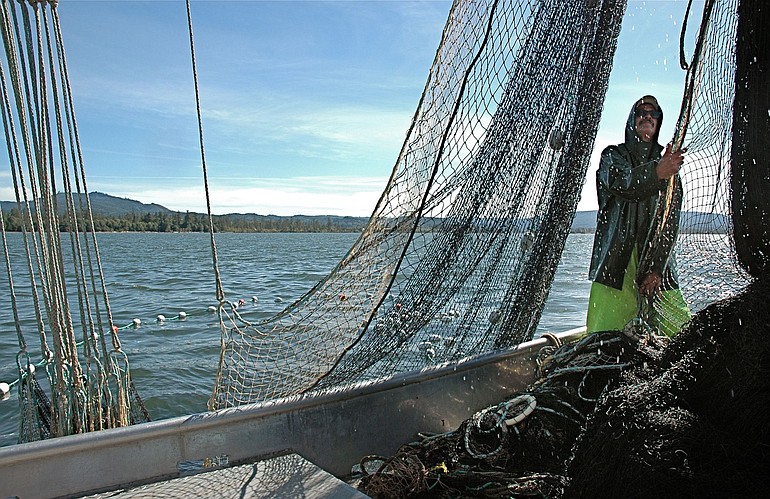In what might seem like a time warp, purse seines, beach seines and fish traps will reappear up and down the Columbia River this summer.
A Washington Department of Fish and Wildlife test of alternative commercial fishing gear will be expanded from last summer’s pilot project, with new work scheduled from mid-August through October.
However, years of further testing are likely before Columbia River commercial fishermen use anything other than gillnets to catch salmon and sturgeon.
Alternatives to gillnets are getting more attention as fishery managers try to increase the catch of hatchery salmon so they don’t compete with wild salmon listed under the Endangered Species Act. At the same time, biologists want to minimize mortality of wild fish that are caught and released.
For more than 50 years, Columbia River commercial fishermen have used only gillnets, which have a mesh size ranging from six to nine inches and trap fish by the gills. Gillnets must be hauled on board boats before the fish can be removed. By that time, fish that must be released may be injured too badly to survive.
Department of Fish and Wildlife officials Sara LaBorde and Pat Frazier gave an update on the alternative gear project recently at a meeting of the Coastal Conservation Association.
Last summer, the agency hired commercial fishermen to test one beach seine, one purse seine and a device called a Merwin trap.
Seines have a 3½-inch mesh and fish can be examined while still in the water.
“We were really pleased with how the fish looked when they came out of the nets,” LaBorde said.
Last summer, the beach seine, which was 660 feet long and 30 feet deep, was set in the water with a skiff off Welch Island near Skamokawa.
It caught as many as 29 chinook and 32 coho per day, but issues arose with timing and hauling it in.
“The biggest thing we found out was you have to have a large high school football team to bring it in,” LaBorde said. “We have to work on that.”
Or a hydraulic power system. Larry Holland of Skamokawa, who operated the beach seine last summer, said he’ll try hydraulic power during this year’s continued testing.
Another disadvantage of beach seining was the time it took to set the nets in place. Tides permitted only three sets a day, Holland said.
Purse seines get their name from the way they work — they’re pulled in to form a circle around fish, then worked from a boat.
During last summer’s testing, the purse seine caught up to 34 chinook and 102 coho per day.
LaBorde said this year’s testing will experiment with seines that are longer than the 650-foot-long net used last summer.
The third device in the tests is a Merwin trap, a floating device similar to a catamaran with a funnel-shaped net suspended below.
Holland said results for that trap tested last summer improved after it was modified, but the best day’s catch for the Merwin device was 15 coho and one chinook.
Fish traps haven’t been widely used on the Columbia for a century; those fishermen “are all dead now,” Holland pointed out. “Now we can’t check anyone’s brains.”
This year’s increased testing results from $1.9 million in federal monies from the Mitchell Act program, which pays for the operation of hatcheries. It will fund five beach seines, six purse seines and two traps, with each type of gear tested for 30 days. The devices will be positioned throughout the lower river as far upstream as the Bonneville Dam area.
The commercial fishermen hired to run the gear won’t be allowed to keep any of the fish. A state observer will be on every boat, Frazier said, to help identify species, gauge the fishes’ condition and document by catch.
Some of the salmon will be kept in net pens for up to 48 hours to see if they survive. “We may need guards,” LaBorde said. “Our biggest fear is what the sea lions will do around these nets.”
Eventually, longer-term mortality surveys may be added, LaBorde said.
LaBorde said the WDFW has consulted with an economist but hasn’t addressed the financial aspects of switching fishing gear.
Commercial fishermen have pointed out that purse seines and net seines require more people to operate than gillnet boats, and a purse seiner typically is larger than a gillnet boat.
LaBorde and Frazier spoke of three or four years of testing before a decision is made on the nets, though the WDFW would need more funding to continue the tests.
Frazier said different types of gear might be best for different species of fish.
Although the law allows the gear to be used for research, decades-old Oregon and Washington state laws that prohibit the use of seines and fish traps would have to be changed.
Ed Wickersham of the CCA said his group wants to see alternative gear replace gillnets, not supplement them. The CCA opposes gillnets on the Columbia because they aren’t selective.
However, the WDFW isn’t opposed to continued use of gillnets, at least some of the time.
“We have always said there is a role” for gillnets, LaBorde said. “There are places, times and species you can fish gillnets. They will be effective and not impact wild populations.”



